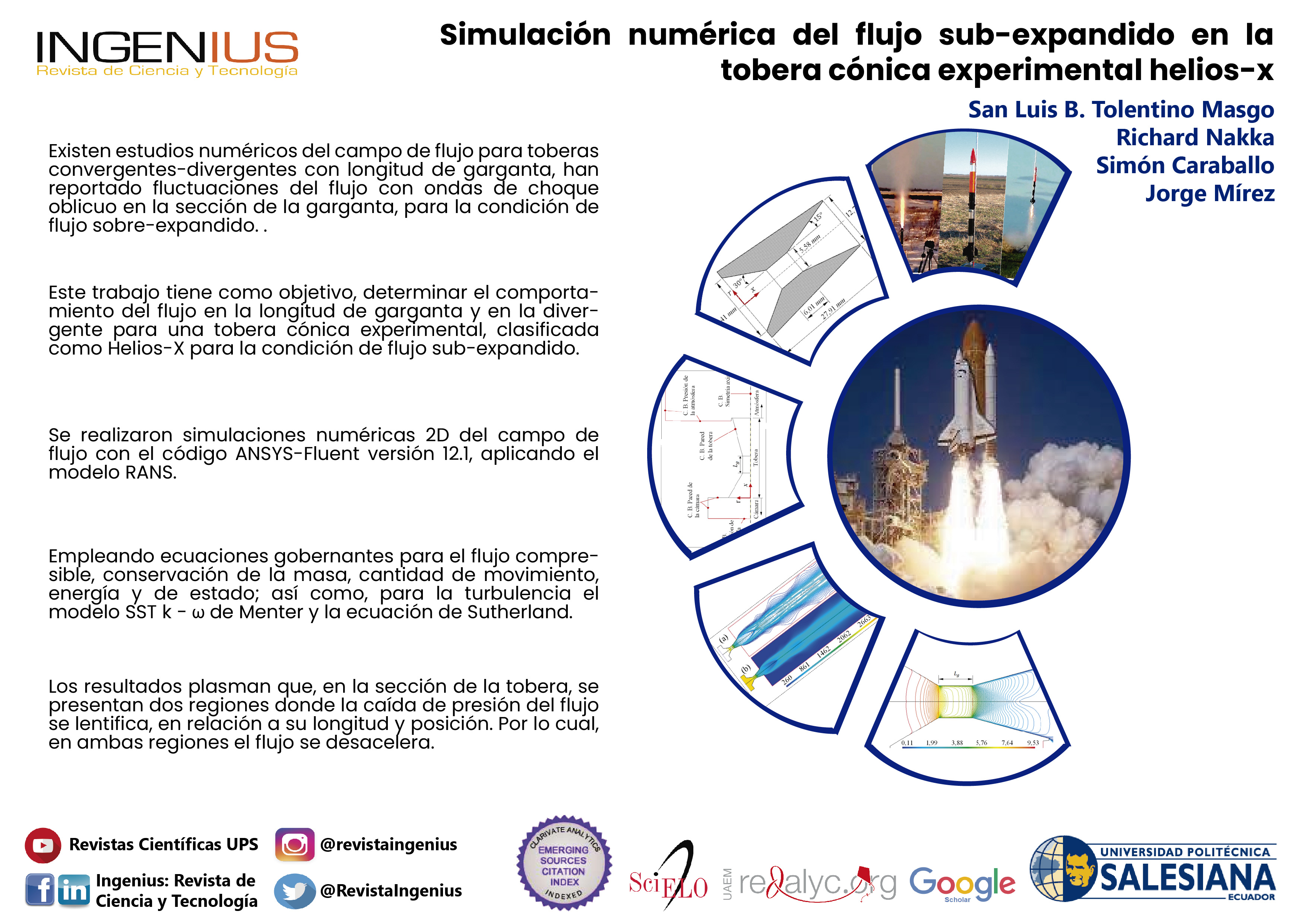Numerical simulation of the under-expanded flow in the experimental conical nozzle helios-x
Main Article Content
Abstract
Keywords
Throat, Fluctuation, Under-expanded, Simulation, Nozzle garganta, fluctuación, subexpandido, simulación, tobera
References
[2] J. Blazek, Computational fluid dynamics: principles and applications. Butterworth-Heinemann, 2015. [Online]. Available: https://bit.ly/3pnxjhx
[3] B. Andersson, R. Andersson, L. Hakansson, M. Mortensen, R. Sudiyo, and B. van Wachem, Computational Fluid Dynamics Engineers. Cambridge University Press, 2011. [Online]. Available: https://bit.ly/32BPCWo
[4] J. D. Anderson, Fundamentals of aerodynamics. McGraw-Hill international editions. Mechanical engineering series, 1984. [Online]. Available: https://bit.ly/3eQR5ge
[5] F. M. White, Fluid Mechanics. McGraw-Hill series in mechanical engineering, 2011. [Online]. Available: https://bit.ly/35opmAy
[6] P. Krehl and S. Engemann, “August toepler – the first who visualized shock waves,” Shock Waves, vol. 5, no. 1, pp. 1–18, Jun. 1995. [Online]. Available: https://doi.org/10.1007/BF02425031
[7] V. Karman, “The fundamentals of the statistical theory of turbulence,” Journal of the Aeronautical Sciences, vol. 4, no. 4, pp. 131–138, 1937. [Online]. Available: https://doi.org/10.2514/8.350
[8] F. White, Viscous fluid flow. McGraw-Hill series in Aeronautical and Aerospace Engineering, 1974. [Online]. Available: https://bit.ly/3eRRCyP
[9] H. Schlichting and K. Gersten, Boundary-Layer Theory. Springer, 2016. [Online]. Available: https://bit.ly/36yZGAx
[10] D. C. Wilcox, Turbulence Modeling for CFD. DCW Industries, Incorporated, 1994. [Online]. Available: https://bit.ly/32HZnCm
[11] A. L. Tolentino, J. Ferreira, M. Parco, L. Lacruz, and V. Marcano, “Simulación numérica del flujo sobre-expandido en la tobera cónica experimental ULA-1A XP,” Unviversidad, Ciencia y Tecnología, vol. 21, no. 84, pp. 126–133, 2017. [Online]. Available: https://bit.ly/2H4yX6k
[12] V. Marcano, P. Benitez, C. La Rosa, L. La Cruz, M. A. Parco, J. Ferreira, R. Andrenssen, A. Serra Valls, M. Peñaloza, L. Rodríguez, J. E. Cárdenas, V. Minitti, and J. J. Rojas, “Progresos alcanzados en el proyecto universitario cohete sonda ULA,” Universidad, Ciencia y Tecnología, vol. 13, no. 53, pp. 305–316, 2009. [Online]. Available: https://bit.ly/3f73vB2
[13] L. Lacruz-Rincón, M. A. Parco-Brizuela, R. Santos-Luque, C. Torres-Monzón, J. Ferreira- Rodríguez, and P. Benítez-Díaz, “Análisis experimental de las oscilaciones de presión interna en un motor de combustible solido para cohete sonda,” Ciencia e Ingeniería, vol. 13, no. 53, 2016. [Online]. Available: https://bit.ly/3noQfdL
[14] Universidad de los Andes. Programa espacial ULA. [Online]. Available: https://bit.ly/35tiodw
[15] S. L. Tolentino Masgo and R. Nakka, “Simulación del flujo supersónico en la tobera del motor cohete Helios-X de categoría amateur,” in Jornadas de Investigación, 2019. [Online]. Available: https://bit.ly/3pwDY8U
[16] R. Nakka. Richard Nakka’s experimental rocketry web site. [Online]. Available: https://bit.ly/2IrDZKX
[17] F. R. Menter, “Two equation eddy-viscosity turbulence models for engineering applications,” Aerospace Research Central, vol. 32, no. 8, pp. 1598–1605, 2012. [Online]. Available: https://doi.org/10.2514/3.12149
[18] A. Balabel, A. M. Hegab, M. Nasr, and S. M. El-Behery, “Assessment of turbulence modeling for gas flow in two-dimensional convergent–divergent rocket nozzle,” Applied Mathematical Modelling, vol. 35, no. 7, pp. 3408–3422, 2011. [Online]. Available: https://doi.org/10.1016/j.apm.2011.01.013
[19] S. L. Tolentino Masgo, “Evaluación de modelos de turbulencia para el flujo de aire en una tobera plana,” INGENIUS, no. 22, pp. 25–37, 2019. [Online]. Available: https://doi.org/10.17163/ings.n22.2019.03
[20] Y. Liu, J. Wu, and L. Lu, “Performance of turbulence models for transonic flows in a diffuser,” Modern Physics Letters B, vol. 30, no. 25, p. 1650326, 2016. [Online]. Available: https://doi.org/10.1142/S0217984916503267
[21] S. L. B. Tolentino Masgo, “Evaluación de modelos de turbulencia para el flujo de aire en un difusor transónico,” Revista Politécnica, vol. 45, no. 1, pp. 25–38, abr. 2020. [Online]. Available: https://doi.org/10.33333/rp.vol45n1.03
[22] Y. Zhang, H. Chen, M. Zhang, M. Zhang, Z. Li, and S. Fu, “Performance prediction of conical nozzle using navier–stokes computation,” Journal of Propulsion and Power, vol. 31, no. 1, pp. 192–203, 2015. [Online]. Available: https://doi.org/10.2514/1.B35164
[23] R. Jia, Z. Jiang, and W. Zhang, “Numerical analysis of flow separation and side loads of a conical nozzle during staging,” Proceedings of the Institution of Mechanical Engineers, Part G: Journal of Aerospace Engineering, vol. 230, no. 5, pp. 845–855, 2016. [Online]. Available: https://doi.org/10.1177/0954410015599798
[24] H. Ding, C. Wang, and G. Wang, “Transient conjugate heat transfer in critical flow nozzles,” International Journal of Heat and Mass Transfer, vol. 104, pp. 930–942, 2017. [Online]. Available: https://doi.org/10.1016/j.ijheatmasstransfer.2016.09.021
[25] A. K. Mubarak and P. S. Tide, “Design of a double parabolic supersonic nozzle and performance evaluation by experimental and numerical methods,” Aircraft Engineering and Aerospace Technology, vol. 91, no. 1, pp. 145–156, Dec. 2020. [Online]. Available: https://doi.org/10.1108/AEAT-12-2017-0275
[26] R. H. Pletcher, J. C. Tannehill, and D. Anderson, Computational Fluid Mechanics and Heat Transfer. CRC Press, 2012. [Online]. Available: https://bit.ly/3psYKX9
[27] D. Munday, E. Gutmark, J. Liu, and K. Kailasanath, Flow Structure of Supersonic Jets from Conical C-D Nozzles. [Online]. Available: https://doi.org/10.2514/6.2009-4005
[28] J. Östlund and B. Muhammad-Klingmann, “Supersonic Flow Separation with Application to Rocket Engine Nozzles ,” Applied Mechanics Reviews, vol. 58, no. 3, pp. 143–177, 05 2005. [Online]. Available: https://doi.org/10.1115/1.1894402



